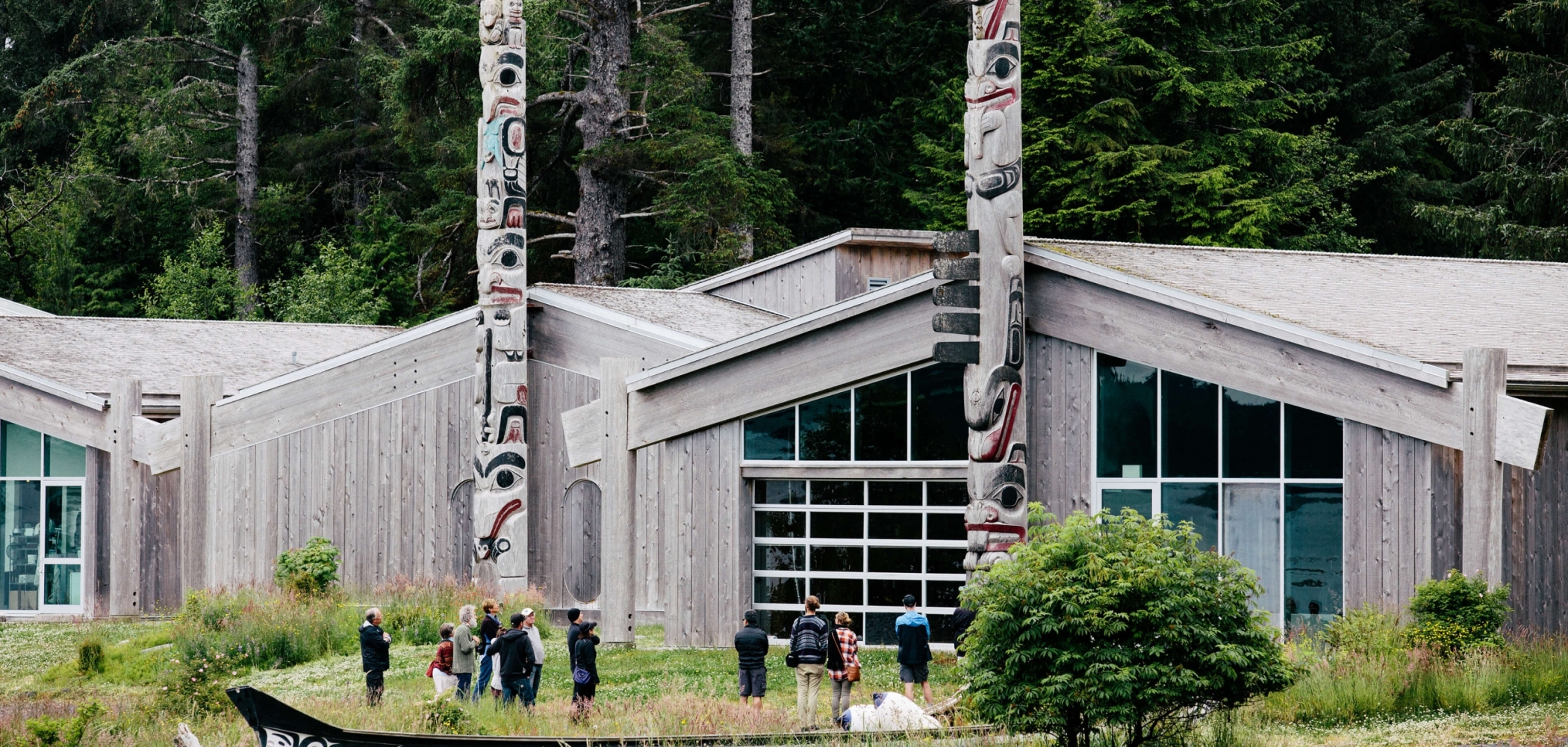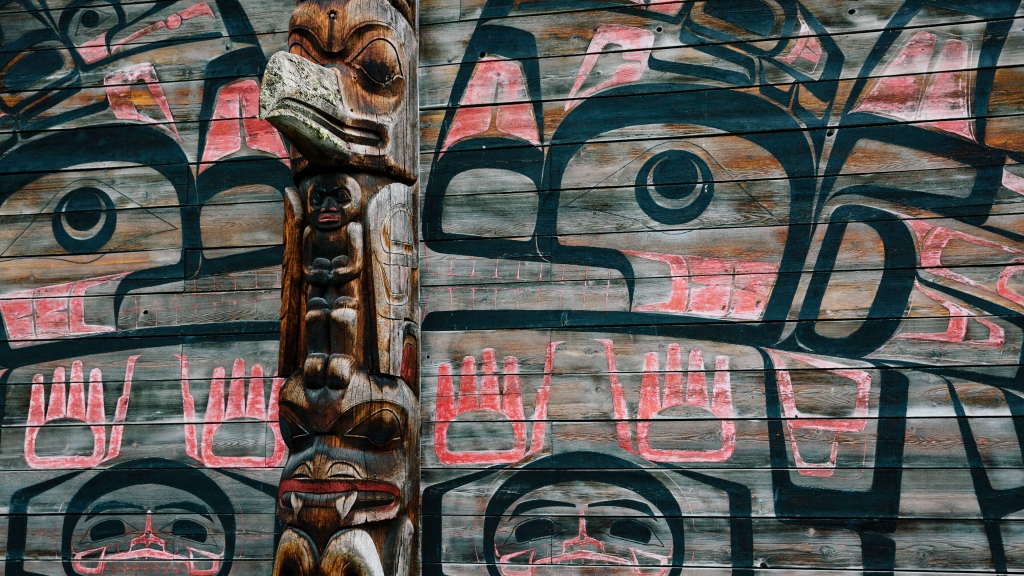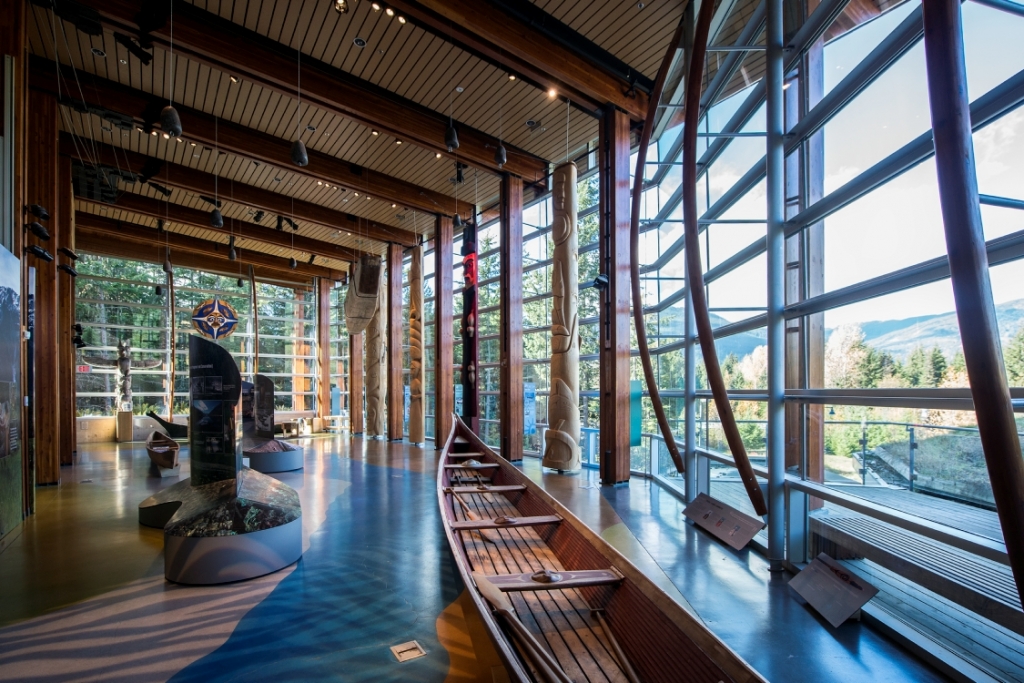
Guest post by Rod Charles
Imagine standing beside an ancient Indigenous artifact, looking up at a totem pole, or listening to an elder tell a story that has been passed down for several generations. Unforgettable activities abound on Canada’s west coast, but what makes visiting these ancestral lands truly special are the stories. The customs and land that supported and defined the great peoples of the ’Ksan, Secwepemc, Squamish, and Haida nations exist today thanks in no small part to their dedicated and diligent ancestors.
Contemporary knowledge keepers working in historical museums have kept the story of Canada’s Indigenous people alive and allowed visitors to make education a part of their vacation experience. All of these museums are operated by members of British Columbia’s Aboriginal communities.
’Ksan Historical Village and Museum

Totem Pole at ‘Ksan Historical Village & Museum | Grant Harder
Since 1960, visitors have been moved by the collection of artifacts at ’Ksan Historical Village and Museum. Located near the ancient village of Gitanmaax, a three-hour drive northeast of Prince Rupert, ’Ksan Historical Village and Museum was an important fishing site and transportation hub for the Gitxsan people. This replicated ancient village contains several original features including houses that form a single line with each building facing the river.
For families, a stay at ’Ksan Campground allows you and your kids to walk in the footsteps of history. ’Ksan’s campground amenities include a play area, hot showers, and well-marked trails, and the area is an ideal spot for anglers and nature-lovers.
Knowledge Nugget: The ’Ksan Historical Village and Museum collection consists of approximately 600 ceremonial and utilitarian materials, including masks, button blankets, shaman’s regalia, and fishing gear.
Nk’Mip Desert Cultural Centre
The Nk’Mip Desert Cultural Centre (pronounced in-ka-meep) is a state-of-the-art interpretive centre and architectural marvel sensitively constructed into a hillside. Extensive indoor and outdoor exhibit galleries create a fun, interactive learning environment with hands-on displays to help you uncover the stories of Canada’s only desert and share in the rich living culture of the Okanagan People.
There are two multi-sensory theatres here, where you can experience the legends of Sen’klip (the Coyote). Discover the desert ecology and wildlife in the “Living Land” display and the “Critter Corner,” and see eye-to-eye with a Western Rattlesnake and a Great Basin Desert Snake.
Knowledge Nugget: In the Inkameep Day school Exhibit, explore a collection of art done by students aged six to sixteen at a school on the reserve in the 1930s.
Squamish Lil’wat Cultural Centre

Squamish Lil’wat Cultural Centre | Blake Jorgenson
The Squamish Lil’wat Cultural Centre in Whistler embodies the spirit of partnership between the two Indigenous communities that inhabit the Whistler area. Both the Squamish (Sk̲wx̲wú7mesh) and Lil’wat (L̓il̓wat7úl) nations are caretakers of the land, and the cultural centre reflects that relationship.
Inspiring tours conducted by Aboriginal ambassadors are offered every hour. Ambassadors share their own stories and first-hand cultural experiences, including the importance of the cedar tree and the significance of the mountains, rivers, and sea. After a fulfilling day, sit back and enjoy a delicious Indigenous-inspired meal at the Thunderbird Cafe.
Knowledge Nugget: You’ll have the chance to get next to a hand-carved journey canoe and marvel at the craftsmanship. Also, be sure to visit the short interpretive trail that passes through a stand of old-growth forest in the Upper Village of Whistler.
U’mista Cultural Centre
The focus of the permanent collection at U’mista Cultural Centre in Alert Bay is the remarkable Potlatch Collection. Other permanent exhibits feature the traditional ethnobiology of the Kwakwa̱ka̱ʼwakw and origin stories of Kwakwa̱ka̱ʼwakw villages, as well as historical and contemporary Kwakwa̱ka̱ʼwakw objects.
Between 1885 and 1951, the potlatch was banned in Canada. After the ban was lifted, the Kwakwaka’wakw people fought for decades for the return of their sacred regalia. Most of the regalia has come home and it is shown here at the U’mista Cultural Centre and at the Nuyumbalees Museum. See this collection of Kwakwa̱ka̱ʼwakw belongings in-place and with Kwakwa̱ka̱ʼwakw Peoples, and engage for reconciliation and cultural resurgence.
Knowledge Nugget: In July and August, traditional Kwakwaka’wakw dances are performed by the Tʼsasała Dance Group.
Haida Heritage Centre at Kay Llnagaay
The stunning, 50,000-square-foot Haida Heritage Centre at Kay Llnagaay opened its doors in 2007. Located in Skidegate on Graham Island, Haida Heritage Centre celebrates the living culture, language, and art of the Haida people, and tells the story of their relationship with the land and sea. This award-winning attraction houses the Haida Gwaii Museum, Performance House, Carving Shed, Canoe House, Bill Reid Teaching Centre, and Kay Bistro.
Don’t miss the Gyaa K’id Naay Carving House, designed to contain monumental poles and canoes, and the Skaajang Naay / Tluu Naay Canoe House, where visitors can learn about the Haida culture.
Knowledge Nugget: Check out the totem poles that were raised in front of Haida Heritage Centre. They represent six of the southernmost villages in Haida Gwaii Skidegate—Ts’aahl, Cumshewa, Skedans, SGang, Gwaay, and Tanu.
Originally published in December of 2017.

See what's happening now with these recent posts.
Plan Your Experience Now
Know Before You Go
Learn about key travel updates and how to travel safely and responsibly in BC.
Travel UpdatesWhere to Stay
Find Indigenous-owned accommodations that celebrate Indigenous culture and community.
Book NowIndigenous BC Trip Planner App
Find authentic experiences and businesses, and hear songs and stories.
Get the AppPlaces to Dine
Share gratitude for the land and each other by sharing a meal with your loved ones.
Indigenous EateriesOnline Shopping
Socially responsible shopping supports Indigenous economies and communities.
Shop Responsibly
